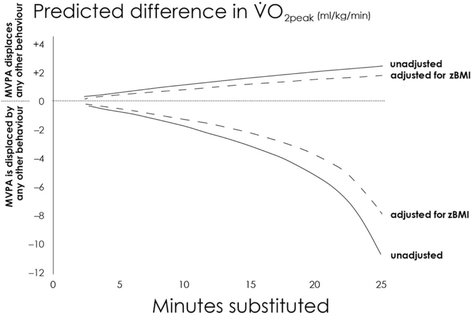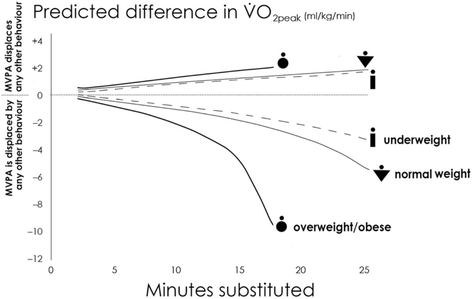Fitness, fatness and the reallocation of time between children's daily movement behaviours: an analysis of compositional data
- PMID: 28486972
- PMCID: PMC5424384
- DOI: 10.1186/s12966-017-0521-z
Fitness, fatness and the reallocation of time between children's daily movement behaviours: an analysis of compositional data
Abstract
Background: Movement behaviours performed over a finite period such as a 24 h day are compositional data. Compositional data exist in a constrained simplex geometry that is incongruent with traditional multivariate analytical techniques. However, the expression of compositional data as log-ratio co-ordinate systems transfers them to the unconstrained real space, where standard multivariate statistics can be used. This study aimed to use a compositional data analysis approach to examine the adiposity and cardiorespiratory fitness predictions of time reallocations between children's daily movement behaviours.
Methods: This study used cross-sectional data from the Active Schools: Skelmersdale study, which involved Year 5 children from a low-income community in northwest England (n = 169). Measures included accelerometer-derived 24 h activity (sedentary time [ST], light physical activity [LPA], moderate-to-vigorous physical activity [MVPA], and sleep), cardiorespiratory fitness determined by the 20 m shuttle run test, objectively measured height, weight and waist circumference (from which zBMI and percent waist circumference-to-height ratio (%WHtR) were derived) and sociodemographic covariates. Log-ratio multiple linear regression models were used to predict adiposity and fitness for the mean movement behaviour composition, and for new compositions where fixed durations of time had been reallocated from one behaviour to another, while the remaining behaviours were unchanged. Predictions were also made for reallocations of fixed durations of time using the mean composition of three different weight status categories (underweight, normal-weight, and overweight/obese) as the starting point.
Results: Replacing MVPA with any other movement behaviour around the mean movement composition predicted higher adiposity and lower CRF. The log-ratio model predictions were asymmetrical: when time was reallocated to MVPA from sleep, ST, or LPA, the estimated detriments to fitness and adiposity were larger in magnitude than the estimated benefits of time reallocation from MVPA to sleep, ST or LPA. The greatest differences in fitness and fatness for reallocation of fixed duration of MVPA were predicted at the mean composition of overweight/obese children.
Conclusions: Findings reinforce the key role of MVPA for children's health. Reallocating time from ST and LPA to MVPA in children is advocated in school, home, and community settings.
Keywords: Accelerometer; LPA; MVPA; Physical activity; Sedentary time; Sleep.
Figures


Similar articles
-
Adiposity, fitness, health-related quality of life and the reallocation of time between children's school day activity behaviours: A compositional data analysis.Prev Med Rep. 2018 Jul 24;11:254-261. doi: 10.1016/j.pmedr.2018.07.011. eCollection 2018 Sep. Prev Med Rep. 2018. PMID: 30109170 Free PMC article.
-
Adiposity and the isotemporal substitution of physical activity, sedentary time and sleep among school-aged children: a compositional data analysis approach.BMC Public Health. 2018 Mar 2;18(1):311. doi: 10.1186/s12889-018-5207-1. BMC Public Health. 2018. PMID: 29499689 Free PMC article.
-
Reallocation of time to moderate-to-vigorous physical activity and estimated changes in physical fitness among preschoolers: a compositional data analysis.BMC Public Health. 2024 Oct 14;24(1):2823. doi: 10.1186/s12889-024-20290-6. BMC Public Health. 2024. PMID: 39402478 Free PMC article.
-
Health outcomes associated with reallocations of time between sleep, sedentary behaviour, and physical activity: a systematic scoping review of isotemporal substitution studies.Int J Behav Nutr Phys Act. 2018 Jul 13;15(1):69. doi: 10.1186/s12966-018-0691-3. Int J Behav Nutr Phys Act. 2018. PMID: 30001713 Free PMC article.
-
The association between reallocations of time and health using compositional data analysis: a systematic scoping review with an interactive data exploration interface.Int J Behav Nutr Phys Act. 2023 Oct 19;20(1):127. doi: 10.1186/s12966-023-01526-x. Int J Behav Nutr Phys Act. 2023. PMID: 37858243 Free PMC article.
Cited by
-
Characteristics of 24-hour movement behaviours and their associations with mental health in children and adolescents.J Act Sedentary Sleep Behav. 2023;2(1):11. doi: 10.1186/s44167-023-00021-9. Epub 2023 Jun 2. J Act Sedentary Sleep Behav. 2023. PMID: 38013786 Free PMC article.
-
The whole day matters: Understanding 24-hour movement guideline adherence and relationships with health indicators across the lifespan.J Sport Health Sci. 2020 Dec;9(6):493-510. doi: 10.1016/j.jshs.2020.07.004. Epub 2020 Jul 22. J Sport Health Sci. 2020. PMID: 32711156 Free PMC article.
-
Cross-Sectional and Longitudinal Associations between Non-School Time Physical Activity, Sedentary Time, and Adiposity among Boys and Girls: An Isotemporal Substitution Approach.Int J Environ Res Public Health. 2021 Apr 27;18(9):4671. doi: 10.3390/ijerph18094671. Int J Environ Res Public Health. 2021. PMID: 33925751 Free PMC article.
-
Physical activity, sedentary behaviour, and sleep in the Thai population: A compositional data analysis including 135,824 participants from two national time-use surveys.PLoS One. 2023 Jan 24;18(1):e0280957. doi: 10.1371/journal.pone.0280957. eCollection 2023. PLoS One. 2023. PMID: 36693050 Free PMC article.
-
Cognitive Performance in Short Sleep Young Adults with Different Physical Activity Levels: A Cross-Sectional fNIRS Study.Brain Sci. 2023 Jan 19;13(2):171. doi: 10.3390/brainsci13020171. Brain Sci. 2023. PMID: 36831714 Free PMC article.
References
-
- Denton SJ, Trenell MI, Plötz T, Savory LA, Bailey DP, Kerr CJ. Cardiorespiratory fitness is associated with hard and light intensity physical activity but not time spent sedentary in 10–14 year old schoolchildren: the HAPPY study. PLoS One. 2013;8:e61073. doi: 10.1371/journal.pone.0061073. - DOI - PMC - PubMed
-
- Kim J, Tanabe K, Yokoyama N, Zempo H, Kuno S. Objectively measured light-intensity lifestyle activity and sedentary time are independently associated with metabolic syndrome: a cross-sectional study of Japanese adults. Int J Behav Nutr Phys Act. 2013;10:30. doi: 10.1186/1479-5868-10-30. - DOI - PMC - PubMed
MeSH terms
LinkOut - more resources
Full Text Sources
Other Literature Sources
Medical
Miscellaneous

